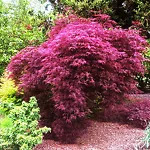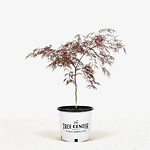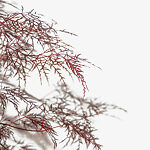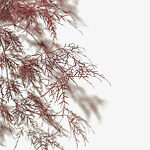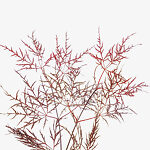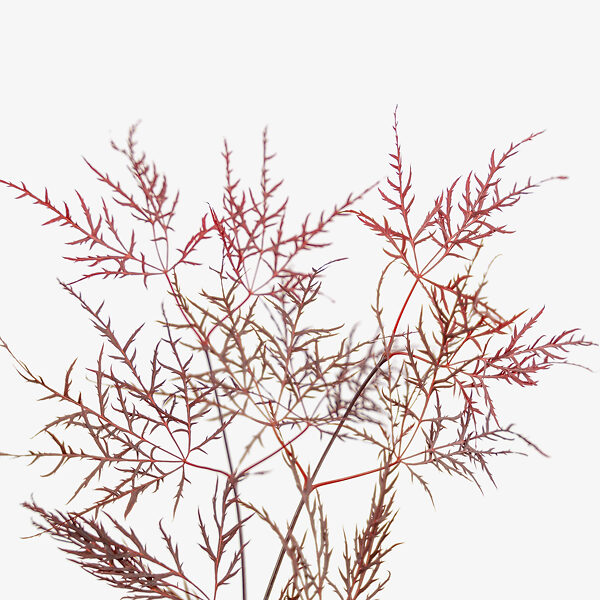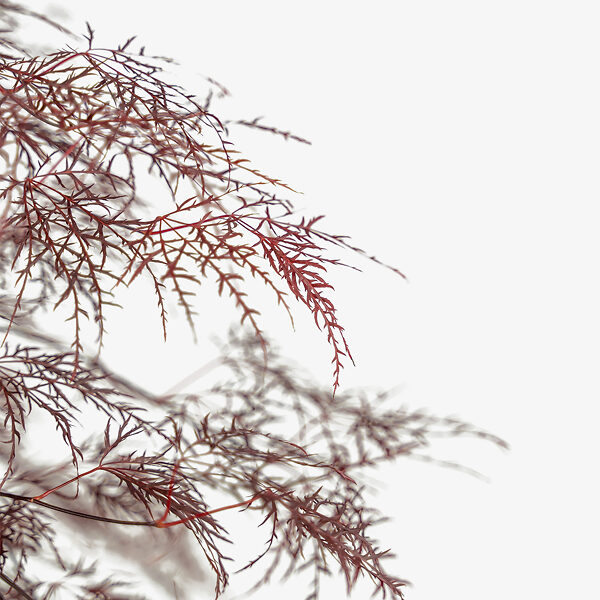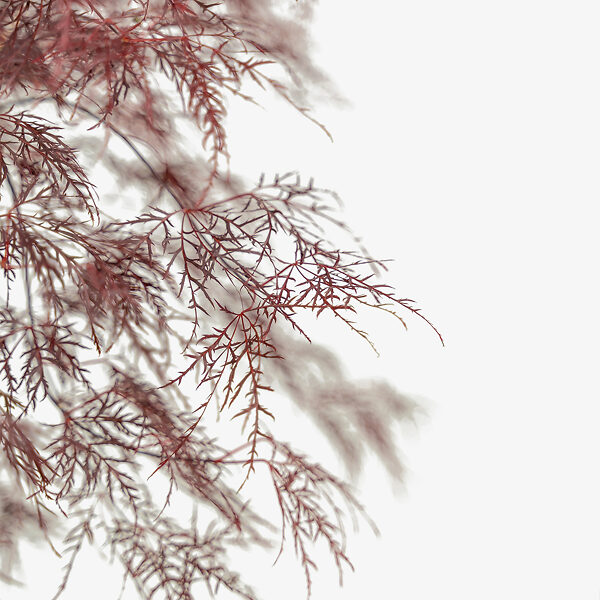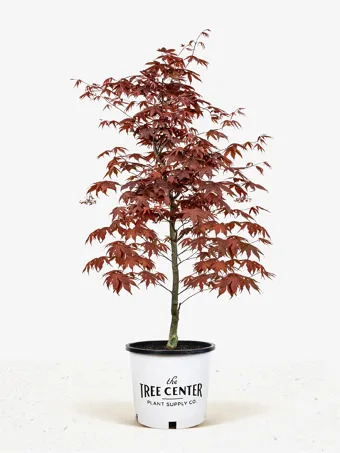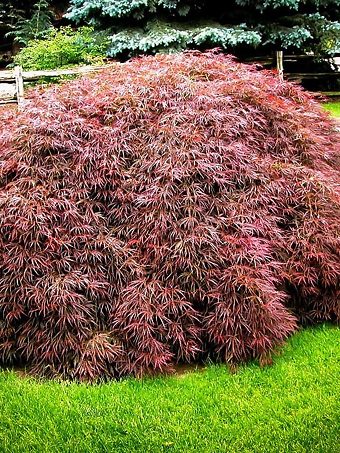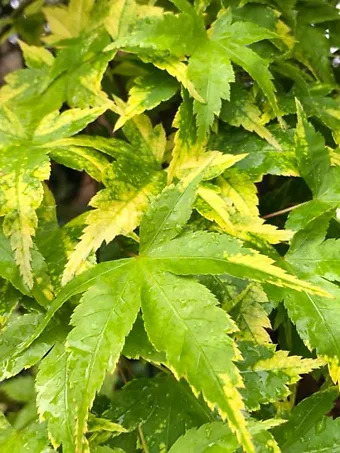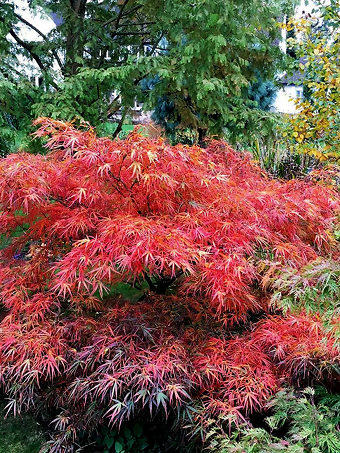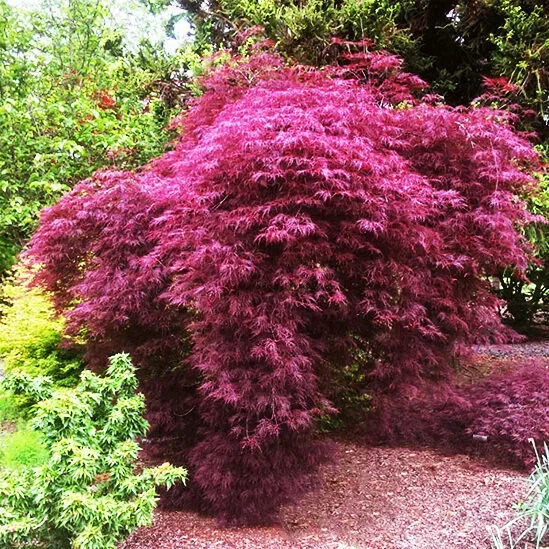
Red Filigree Lace Japanese Maple
Acer palmatum 'Red Filigree Lace'View more from Japanese Maple Trees
Red Filigree Lace Japanese Maple
Acer palmatum 'Red Filigree Lace'
30 day - ARRIVE AND THRIVE™ guaranteeLearn more


Special Features

Botanical Name
Acer palmatum 'Red Filigree Lace'
Outdoor Growing zone
5-9
Mature Height
2-4
Mature Width
3-5
Sun needs
Partial Sun
DOES NOT SHIP TO
AK, CA, HI, PR
The Red Filigree Lace Japanese Maple is a wonderful specimen tree for that special place in your garden. It grows into a broad, mounded plant with cascading branches, creating a graceful profile in all seasons. The exceptional slender twigs form a lacey network in winter, but it is the very finely-divided leaves, with 7 slender lobes, that create the gorgeous filigree effect. The leaves open in spring a rich burgundy, and they turn to a darker maroon in summer, without greening. In fall they become a vibrant, bright red. All year this plant is remarkable, and it is among the very best and most select of all the dissected Japanese maples.
- Beautiful mounded small tree with slender cascading branches
- Very finely-divided lacey leaves
- Leaves are burgundy in spring, maroon in summer and red in fall
- Perfect tree for a focal point or special location
- Leaves don’t turn green in summer, or in shade
Grow the Red Filigree Lace Japanese Maple in a sheltered place in zone 5, and in all warmer zones. It should be planted where it receives morning sun and afternoon shade, especially in warmer zones, or in the dappled shade beneath tall deciduous trees. The soil should be rich and moist, but well-drained, and the roots should not become dry. Use mulch to conserve moisture and keep the soil cool. This tree doesn’t usually suffer from pests or diseases, and it will become an outstanding specimen worthy of the best gardens.
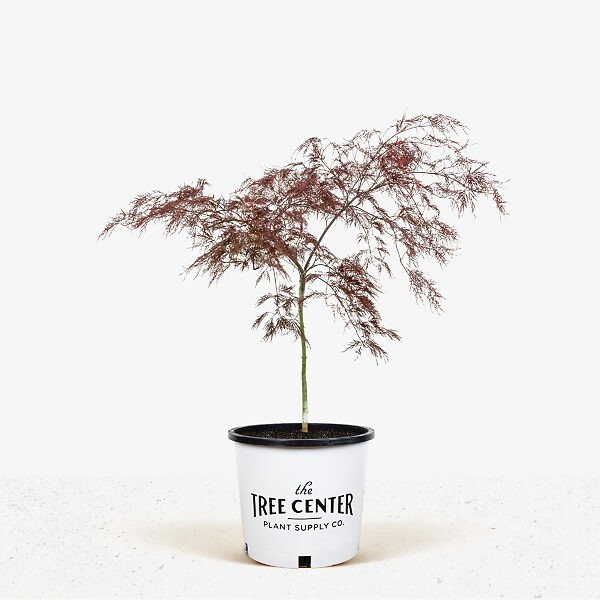
Japanese maples are among the most beautiful of specimen shrubs, and they are available in many sizes and forms. Cascading plants are especially beautiful and graceful. So are forms with finely-divided leaves. The most popular varieties often have red leaves, a perennial favorite with gardeners. Combine all these features together in a single plant, and one that is small enough for a city garden or courtyard, and you have the Red Filigree Lace Japanese Maple. This beautiful plant has the most finely-divided leaves of any Japanese maple variety, and its mounded, cascading shape is striking and beautiful. Its wonderful red leaves hold their color not only all summer – an accomplishment in itself – but they also stay red even in shady places, an almost unique feature among these trees. If you are looking for the perfect specimen small tree for a prime spot in your garden, you have just found it.
Growing the Red Filigree Lace Japanese Maple
Size and Appearance
The Red Filigree Lace Japanese Maple is a small shade tree, growing to about 4 feet tall and wide, and eventually larger. It is slower growing than some other Japanese Maples, adding between 3 and 6 inches a year to the length of its branches. These grow upwards at a low angle, and then cascade downwards, creating a beautiful mound of branches with a soft cloud-like profile. In winter the bare branches create a beautiful lacey effect, rivaled only by the laciness of the leaves.
The leaves of the Red Filigree Lace Japanese Maple are long, between 3 and 4 inches, but this is not immediately obvious. They have a long leaf stalk, which ends in 5 to 7 leaf lobes, which are very slender and thread-like, with short side lobes, also cut and divided. This is an extreme example of the ‘Dissectum’ type of Japanese maple, and this variety is recognized as having among the finest and most lace-like of all the dissected Japanese maples. When they first emerge in spring the new leaves are bright burgundy and a striking focal point in any garden. As summer arrives, they turn a deeper maroon-red, but they do not turn greenish, as some older types of red-leaf maple do, even when this plant is growing in shade. Then in fall all the stops come out, and the leaves turn a bright, vibrant red, bringing this magnificent plant to the forefront of your garden once again.
Using the Red Filigree Lace Japanese Maple in Your Garden
This unique plant deserves a special location in your garden. Use it as a striking specimen in a bed, or plant it by a pond. It is perfect for a courtyard or similar space where there are few plants, but where each one is a superb individual. A plant like this will lift your Asian-themed garden to a higher dimension. This tree is also perfect for growing in a planter or container, in any style of garden, to make an eye-catching specimen, or even an exceptional bonsai tree.
Hardiness
The Red Filigree Lace Japanese Maple is hardy from zone 5 to zone 9, but in zone 5 it should be planted in a sheltered place, protected from cold winds, and given some winter protection during its early years.
Sun Exposure and Soil Conditions
The Red Filigree Lace Japanese Maple can be grown in a wide range of light conditions, from full sun to light full shade. The dappled shade beneath larger deciduous trees is often ideal, if the soil is not too dry. Morning sun and afternoon shade, particularly in summer, are good conditions, and give the best leaf colors. Because it has very slender leaves it is more prone to sun-scorch than some other varieties, so its placement should be considered carefully. The soil should be rich and moist, but well-drained, and poorer soils should be enriched with organic materials when planting. The amount of light exposure should be linked to the soil conditions – the more consistent watering is, the more sun this tree will tolerate.
Pruning and Maintenance
No pruning is required other than removing any dead twigs that may develop as the crown of your tree grows and matures. Always cut back to a bud to avoid leaving dead ends on the branches. You can also open up some of the inside of the tree as it grows, to show the interesting trunk structure and bark texture, and to give the tree a more ‘mature’ look sooner.
This tree is generally free of pests or diseases, and the only maintenance needed is to apply mulch over the root-zone every spring, to feed your tree, conserve moisture, and keep the roots and soil cool. Pay careful attention to keeping the soil moist, especially during dry periods and hot weather. Trees of this quality and uniqueness do require a little more care than many of our Japanese maples with broader leaf structures, but this tree is resilient and surprisingly hardy, given its remarkable appearance. If you are uncertain, or have limited experience with Japanese maples, we recommend some of our other varieties, which are also beautiful, but may be easier for you to grow.
History and Origins of the Red Filigree Lace Japanese Maple
The Japanese maple, Acer palmatum, is a small tree native to Japan and China. It grows naturally beneath larger trees in forests, and special forms have been collected for centuries, first in Asia, and later in North America and Europe. The variety called ‘Red Filigree Lace’, appeared in the 1950s as a seedling among a batch of plants grown by the nurseryman William Curtis, in Sherwood, Oregon. The original plant changed hands several times among collectors, and it wasn’t until the 1980s that Iseli Nursery in Boring, Oregon mastered its propagation, and made it available to a wider audience of gardeners.
Buying the Red Filigree Lace Japanese Maple at The Tree Center
We have been fortunate to obtain some specimens of this tree. It is among the most difficult of all the Japanese Maples to reproduce, because of the delicate, thin twigs. Once done, however the plants are robust. Trees like this are radically superior to the random seedling plants often offered at lower prices, so don’t be fooled, and only settle for the very best. But act now, because plants of this quality and rarity only remain on our stock-list for a very short time.
